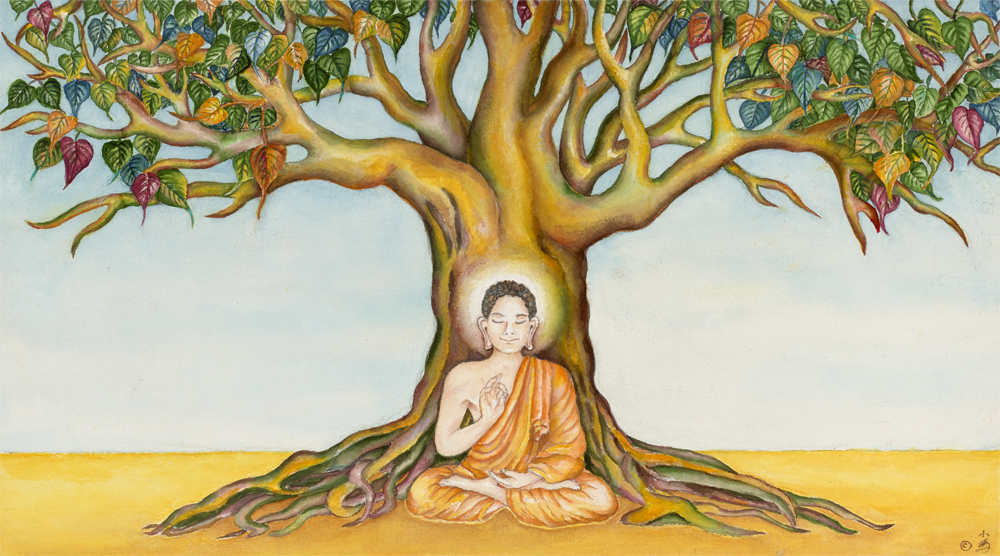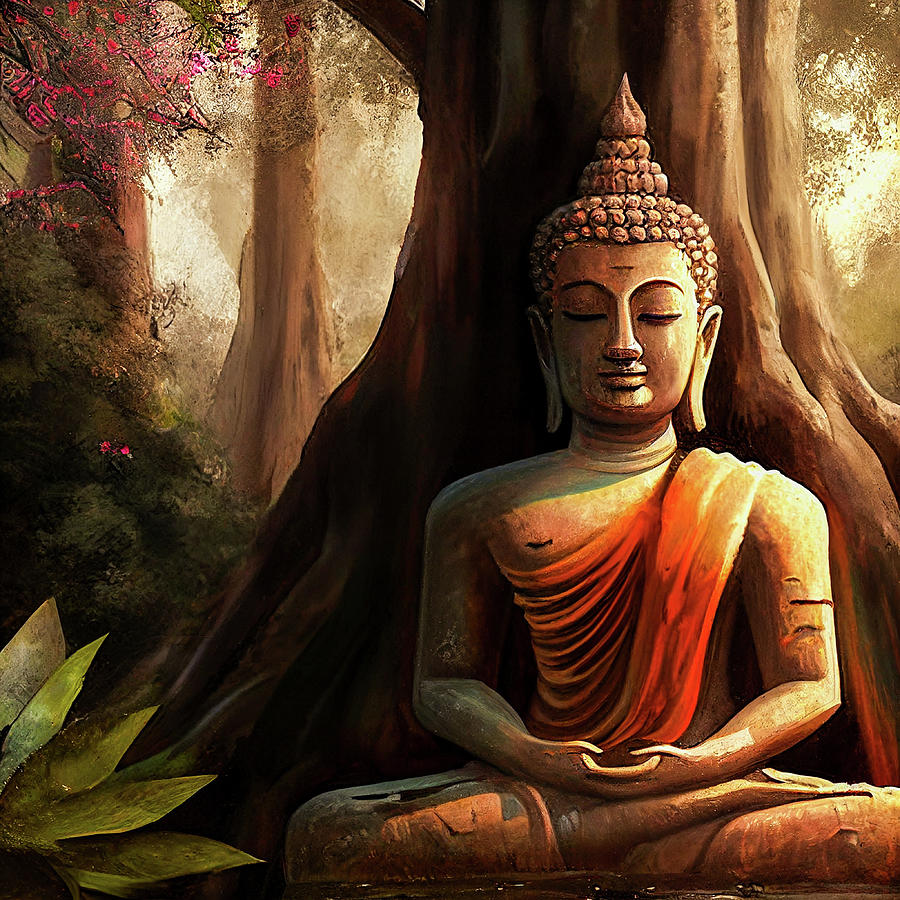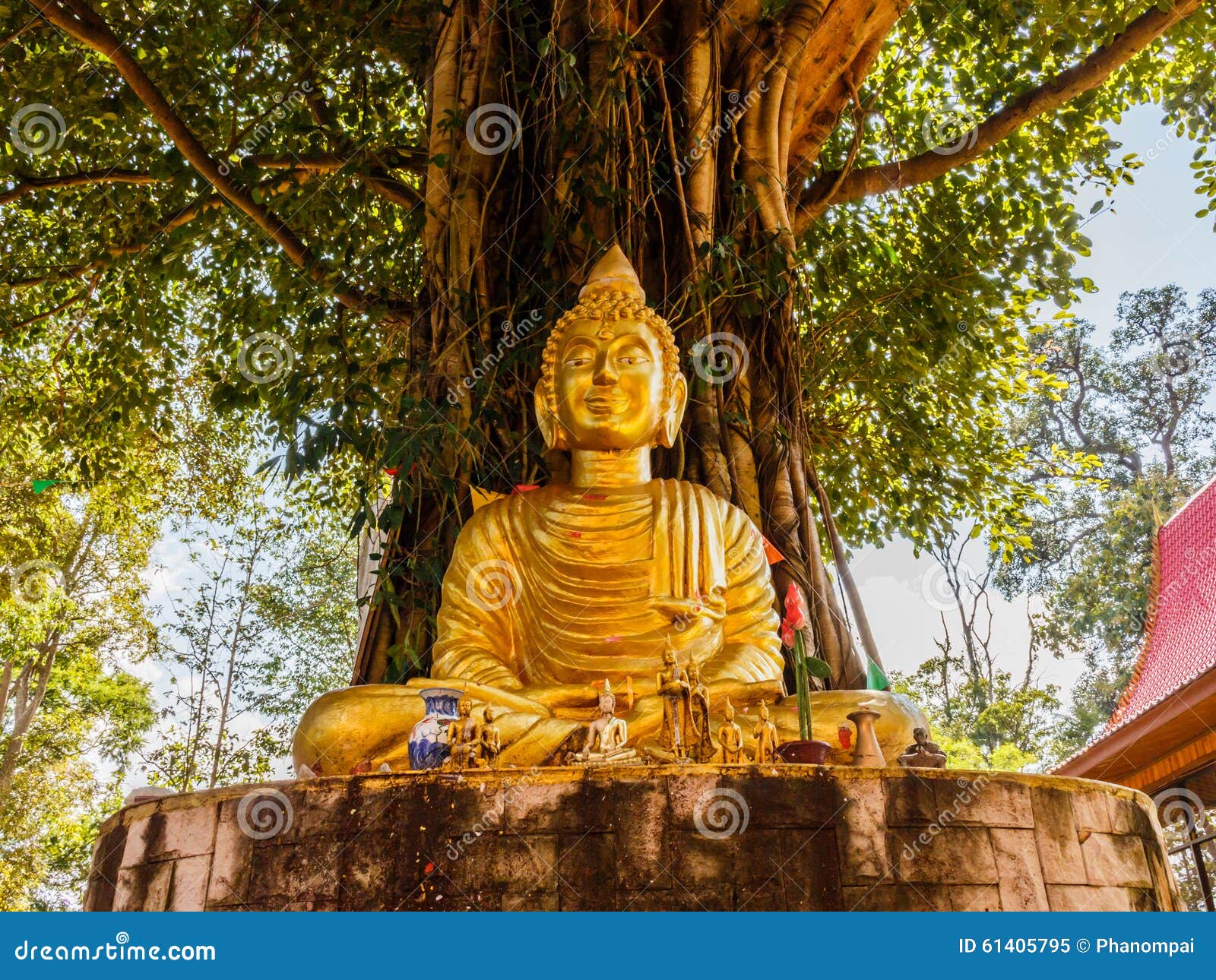The Bodhi Tree - A Sacred Story Of Awakening
Imagine a tree, not just any tree, but one that stands as a silent witness to a moment that changed the course of human thought. This isn't just a tale from long ago; it's a story that still echoes through the ages, rooted deeply in spiritual belief. We're talking about a very special fig tree, one that has a unique spot in the collective memory of so many people across the globe. It's a living symbol, you know, of profound peace and deep wisdom, a place where something truly extraordinary happened.
This particular tree, often called the Bodhi tree, or sometimes just the Bo tree, is more than simply a plant. It's a focal point for spiritual journeys, a place where people find a kind of quiet strength. Its story is really tied to a significant event, a moment of deep insight that continues to shape how countless individuals approach their lives and their inner experiences. It's quite something, actually, how one tree can hold such a powerful meaning for so many.
Its location is a spot in India, in a place called Bodh Gaya, within the state of Bihar. This specific geographic point, found at roughly 24°41′45.29″ north and 84°59′29.29″ east, marks where this incredibly important natural wonder once stood. Even though the original tree is no longer there in its first form, its spirit, you could say, lives on through its descendants and the stories told about it. It’s a very tangible link to a powerful past, a bit like a living piece of history.
- Great Wolf Lodge Lagrange Ga
- The Bond Between
- Studio Movie Grill Alpharetta
- 5th Avenue Theatre
- Citadines Les Halles Paris
Table of Contents
- What Makes the Bodhi Tree So Special?
- The Bodhi Tree and Its Enlightened Connection
- A Living Symbol - The Bodhi Tree in Spiritual Paths
- How Did the Bodhi Tree Become So Well-Known?
- The Bodhi Tree - A Long and Unbroken Line
- What is the Bodhi Tree's Place in Art and Culture?
- The Bodhi Tree's Roots of Meaning
- Where Can We Find the Bodhi Tree's Descendants?
What Makes the Bodhi Tree So Special?
The Bodhi tree, often spoken of as the "Tree of Awakening" or the "Tree of Enlightenment," is a rather big sacred fig tree. Its botanical name is Ficus religiosa, and it holds a truly deep spot in many spiritual ways of thinking, particularly in Buddhism. This tree isn't just a natural wonder; it is, in a way, a living monument. It's a place where, according to Buddhist accounts, Siddhartha Gautama, the spiritual teacher who later became known as the Buddha, sat down. It was under the shade of this very tree that he found a kind of deep peace and clear sight, what is called "Bodhi." This event, you know, marked a turning point, not just for him but for so many who came after.
This sacred fig tree is, honestly, a pretty remarkable piece of nature. Its branches spread wide, offering a lot of shade, and its roots run deep, giving it a solid hold on the earth. It's quite a sight to see, really, with its heart-shaped leaves that flutter in the slightest breeze. The way it looks, its sheer presence, seems to suggest something ancient and wise. It's a tree that tends to inspire a feeling of quiet wonder, a bit like looking at something that has seen many, many seasons pass. People often feel a sense of calm just being near it, which is, you know, part of its charm.
For those who follow Buddhist traditions, the specific Ficus religiosa under which the Buddha sat at Bodh Gaya is extremely important. It's not just a tree; it's a place of transformation. This tree has become a central symbol in Buddhism, and it is considered, quite remarkably, the oldest continually documented tree in the entire world. This means that its story, its lineage, has been carefully kept track of for a very long time. That kind of history, you know, gives it a special weight, making it a living link to something truly ancient and powerful.
- Marcus Century Cinema
- Richmond Animal League
- Walmart Auburn Maine
- Awc Yuma
- Culvers Flavor Of The Day Near Me
The Bodhi Tree and Its Enlightened Connection
The core of the Bodhi tree's fame comes from its direct link to Siddhartha Gautama's path to becoming the Buddha. He sat beneath its branches, seeking a profound insight, a way to truly understand suffering and how to move past it. This moment, when he achieved enlightenment, is the reason this particular tree is so deeply respected. It symbolizes the very path to inner awakening, a journey toward a state of clear wisdom and deep peace, often called Nirvana. It's a powerful reminder, really, of what is possible when one seeks truth with great determination.
This event, the Buddha's enlightenment under the Bodhi tree, is a cornerstone of Buddhist teaching. It tells a story of perseverance, of looking within, and of finding answers not in external things, but in one's own mind. The tree itself, therefore, becomes a kind of silent partner in this profound personal discovery. It's almost as if the tree absorbed some of that peaceful energy, radiating it out to all who come near. People often visit the site, you know, to feel that connection, to seek their own moments of quiet reflection.
The story of the Bodhi tree is also about the idea of spiritual growth. Just as a tree grows from a tiny seed into something vast and strong, the Buddha's journey showed how an individual could grow in understanding. The tree, in this way, represents that unfolding, that reaching for a higher state of being. It's a simple yet very strong image, really, that speaks to the human desire for meaning and for a deeper connection to life.
A Living Symbol - The Bodhi Tree in Spiritual Paths
The Bodhi tree holds a deep spiritual meaning across many cultures, especially within Buddhism. It's looked upon as a symbol of enlightenment and wisdom, a guiding light for those on a spiritual quest. But it also stands for strength and resilience, much like a strong tree that can withstand many storms. It's a kind of quiet teacher, you know, showing us that even in stillness, there can be great power and deep understanding.
This tree's place in spiritual thought is pretty old, actually. Even before Buddhism became widespread, the Ficus religiosa was considered sacred by people in Southeast Asia. This suggests that there was always something about this tree that inspired reverence, perhaps its long life, its impressive size, or its ability to provide shelter. It's a natural marvel that just seems to draw people in, making them feel a sense of something larger than themselves.
In Buddhist art and practices, the Bodhi tree is a very important object. You'll see it depicted in various forms, from paintings to sculptures, always representing that moment of awakening. It's a visual reminder of the Buddha's path and a source of inspiration for practitioners. It's almost like a constant presence, a steady point of reference for those seeking their own moments of insight.
How Did the Bodhi Tree Become So Well-Known?
The fame of the Bodhi tree grew as the teachings of the Buddha spread. As people learned about Siddhartha Gautama's journey and his profound experience under this tree, the tree itself became a place of pilgrimage. People wanted to visit the spot where such a significant event took place, to feel the atmosphere and perhaps gain some inspiration for their own lives. It's a bit like visiting a historical landmark, but with a deep spiritual purpose.
Over time, stories about the tree were passed down, both orally and in written texts. These accounts helped to solidify its place in the collective consciousness. The fact that it's considered the oldest continually documented tree in the world also adds to its legendary status. This kind of unbroken history, you know, makes it truly unique. It’s not just a story; it’s a living lineage that connects us to a very distant past.
Even though the original tree from the Buddha's time no longer exists, its direct descendants have been carefully preserved and replanted in various places. This act of preservation has helped to keep its story alive and its symbolism strong. It's a testament, really, to the enduring power of its meaning and the dedication of those who wish to honor its legacy. This continuous presence, in a way, ensures that its story will keep inspiring people for generations to come.
The Bodhi Tree - A Long and Unbroken Line
The original Bodhi tree, the one under which Siddhartha Gautama found enlightenment, is not physically present today. However, its legacy lives on through a remarkable lineage of trees. One of the most famous examples is the Jaya Sri Maha Bodhi, a sacred Bo tree located in Sri Lanka. This tree was planted from a cutting taken directly from the original Bodhi tree in India. This act of transplanting a part of the original tree created a direct, living connection to that profound moment of awakening. It's quite an incredible story, really, of how a piece of history can be carried forward.
The history of these cuttings and replantings is a significant part of the Bodhi tree's story. It shows how important this tree was, and still is, to people. The care taken to transport and replant these cuttings speaks volumes about the reverence it holds. It’s a bit like carrying a precious torch, ensuring its flame never goes out. These descendant trees serve as living reminders, allowing people to connect with the essence of the original.
Spiritual figures throughout history have meditated under the shade of these Bodhi trees, both the original and its descendants. This practice continues today, with people seeking quiet contemplation and insight in its presence. The tree, therefore, isn't just a historical artifact; it's a living space for spiritual practice, a place where people can truly pause and reflect. It offers a kind of peaceful sanctuary, you know, for those seeking inner quiet.
What is the Bodhi Tree's Place in Art and Culture?
The Bodhi tree is a very important part of Buddhist art and images. You'll find it appearing again and again in paintings, sculptures, and other forms of creative expression related to Buddhism. Its presence in these works helps to tell the story of the Buddha's life and his teachings. It's a way for artists to convey deep spiritual ideas through a recognizable and powerful symbol. This consistent appearance, you know, shows just how central it is to the tradition.
Even before the rise of Buddhism, this particular tree, the Ficus religiosa, was considered sacred by people in Southeast Asia. This means its cultural importance goes back even further than its Buddhist connection. It suggests that there was something about its natural qualities – perhaps its size, its longevity, or its distinctive leaves – that inspired a sense of awe and reverence in various communities. It’s almost like it has a natural aura that draws people to it.
The tree's image is not just a decorative element; it carries a deep symbolic weight. It represents the path to spiritual liberation, the overcoming of difficulties, and the attainment of wisdom. When people see the Bodhi tree in art, it reminds them of these profound concepts and encourages them to reflect on their own spiritual journeys. It's a very powerful visual cue, really, that speaks to the heart of what Buddhism is about.
The Bodhi Tree's Roots of Meaning
The Bodhi tree is sometimes called the "tree of life," a name that speaks to its deep symbolism. Its roots, in particular, are often seen as representing the very origins of all actions, the fundamental impulses that drive us. In some interpretations, its three healthy roots symbolize core positive qualities: love, wisdom, and a sense of understanding. This way of looking at the tree gives it a very personal meaning, connecting it to the inner workings of human experience.
This symbolism goes beyond just the story of the Buddha. It speaks to universal ideas of growth, stability, and connection. A tree's roots keep it firmly planted, drawing nourishment from the earth, much like our core values and beliefs give us stability and help us grow. It's a simple, yet very profound, way to think about how we live our lives and what truly matters.
The idea that the Bodhi tree represents love, wisdom, and understanding suggests that these qualities are foundational, just like a tree's roots. They are the things that support our spiritual and emotional well-being. This kind of symbolism makes the Bodhi tree a powerful image for anyone seeking to cultivate a more meaningful existence, regardless of their specific beliefs. It’s a bit like a gentle reminder, you know, to nurture what truly sustains us.
Where Can We Find the Bodhi Tree's Descendants?
The most famous descendant of the original Bodhi tree is the Jaya Sri Maha Bodhi in Sri Lanka. This sacred Bo tree, as mentioned, was grown from a cutting of the original tree in India, where the Buddha found enlightenment. It's located in Anuradhapura, Sri Lanka, and is a deeply revered site for Buddhists around the world. Its long history and direct connection to the original make it an incredibly special place, a kind of living relic.
The Bodhi tree at Bodh Gaya, while not the exact original, is still the primary location where the Buddha attained his awakening. It's part of the Mahabodhi Temple complex, a major pilgrimage site. This location, at Bodh Gaya in northeastern India, is considered by many to be the most sacred spot on earth for Sri Lankan Buddhists, and it remains the oldest historical tree in the world with a written history. It's a place where you can really feel the weight of centuries of devotion.
Beyond these two prominent locations, cuttings and saplings from the Bodhi tree have been shared and planted in various countries where Buddhism is practiced. This spreading of the tree's lineage helps to connect Buddhist communities globally to this central symbol. It shows how the tree is revered in different places, becoming a shared point of reference for spiritual practice and cultural identity. It's a very tangible way, you know, to spread the message of peace and awakening.
These descendant trees are cared for with great respect, reflecting their cultural, historical, and botanical importance. They are recognized for their unique features, their impressive longevity, and even some traditional medicinal uses, though those are less central to their spiritual role. Their continued existence allows people to experience a direct link to the story of the Buddha and the profound moment of his enlightenment, keeping the spirit of the Bodhi tree alive and well.
In short, we've explored the history, the rich symbolism, and the enduring importance of the Bodhi tree. We've seen how this sacred fig tree, Ficus religiosa, became a central figure in Buddhist tradition because of its connection to Siddhartha Gautama's enlightenment at Bodh Gaya. From its geographical coordinates to its botanical name, and its role as a "tree of life" symbolizing love and wisdom, the Bodhi tree holds a truly unique place. Its lineage, extending to places like the Jaya Sri Maha Bodhi in Sri Lanka, continues to inspire spiritual seekers and stands as a powerful symbol of awakening and inner peace for countless individuals across the globe.

Bodhi Tree Buddhism | ubicaciondepersonas.cdmx.gob.mx

Buddha under the Bodhi Tree Digital Art by Billy Bateman - Pixels

Buddha And The Bodhi Tree Stock Photography | CartoonDealer.com #76948184